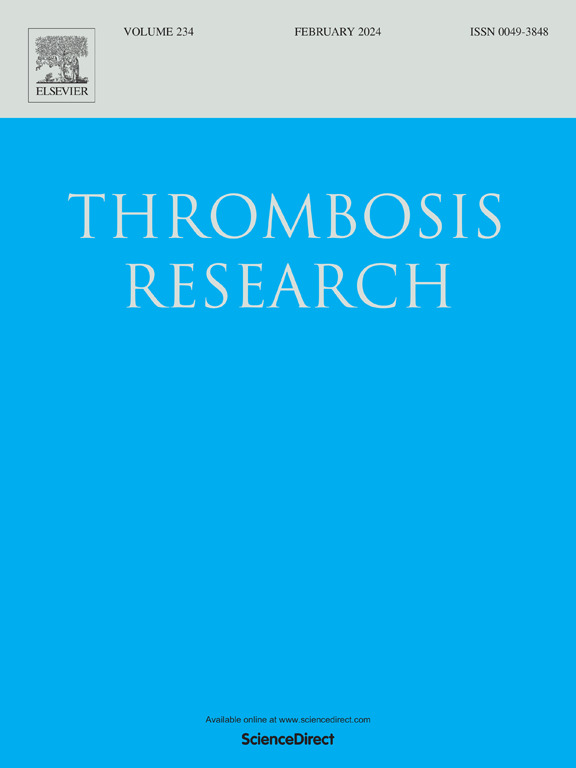Erythrocyte rheology is altered in haemophilia patients with advanced arthropathy. A case-control study
IF 3.4
3区 医学
Q1 HEMATOLOGY
引用次数: 0
Abstract
Background
Haemophilia goes along with a lack of clotting factors, which can lead to bleedings mostly being of intraarticular nature. These patients (PwH) suffer from health implications attributed to the resulting haemophilc arthropathy. Even though the haemostatic system is widely studied in PwH, little is known about red blood cell (RBC) rheology. This study aims to explore RBC rheology focussing on deformability and aggregation in PwH and to describe potential influencing factors.
Methods
27 PwH and 27 healthy controls (HC) were included in this study. RBC deformability (EImax, SS½, SS½/EImax ratio) and aggregation (AI, Shear stress at disc min) were measured using ektacytometry and obtained from syllectograms. Haematological parameters were determined. The Haemophilia Joint Health Score (HJHS) was assessed indicating musculoskeletal impairment. Pain and pain sensitivity were measured using numeric rating scales and pressure algometry. Subjective physical functioning was assessed via questionnaires.
Results
PwH possess higher HJHS scores than HC (p < .001) with a range of 11–69 points. All RBC deformability parameters (p ≤ .007) and Shear stress at disc min (p < .001) are impaired in PwH compared to HC. Regarding haematological parameters, only red cell distribution width (p = .049) and haemoglobin (p = .024) were different. PwH reveal higher pain states (p ≤ .002) and lower physical functioning (p < .001).
Conclusions
This study is the first to investigate RBC rheology in PwH with haemophilic arthropathy and shows that RBC rheological properties, particularly deformability, are impaired in this population. These observations might be attributed to advanced joint restrictions and higher pain states in PwH resulting in lower physical activity as well as to present co-morbidities and co-medication.

血友病伴晚期关节病患者红细胞流变学改变。病例对照研究
血友病伴随着凝血因子的缺乏,这可能导致出血,主要是关节内的性质。这些患者(PwH)遭受归因于由此产生的血友病关节病的健康影响。尽管在PwH中对止血系统进行了广泛的研究,但对红细胞(RBC)流变学知之甚少。本研究旨在探讨红细胞流变学在PwH中的可变形性和聚集性,并描述潜在的影响因素。方法选取27例PwH和27例健康对照(HC)。红细胞变形能力(EImax, SS½,SS½/EImax比率)和聚集性(AI,圆盘最小剪应力)采用分光光度法测量,并从分子图中获得。测定血液学参数。血友病关节健康评分(HJHS)评估显示肌肉骨骼损伤。采用数值评定量表和压力测量法测量疼痛和疼痛敏感性。主观身体功能通过问卷进行评估。结果spwh的HJHS评分高于HC (p <;.001),范围为11-69分。所有RBC变形能力参数(p≤0.007)和阀瓣最小剪切应力(p <;.001)在PwH中与HC相比受损。在血液学参数方面,只有红细胞分布宽度(p = 0.049)和血红蛋白(p = 0.024)存在差异。PwH表现出较高的疼痛状态(p≤0.002)和较低的身体功能(p <;措施)。结论:本研究首次对伴有血友病的PwH患者的红细胞流变学进行了研究,结果显示RBC流变学特性,尤其是可变形性在该人群中受损。这些观察结果可能归因于PwH的晚期关节限制和更高的疼痛状态,导致身体活动减少,以及出现合并症和共同用药。
本文章由计算机程序翻译,如有差异,请以英文原文为准。
求助全文
约1分钟内获得全文
求助全文
来源期刊

Thrombosis research
医学-外周血管病
CiteScore
14.60
自引率
4.00%
发文量
364
审稿时长
31 days
期刊介绍:
Thrombosis Research is an international journal dedicated to the swift dissemination of new information on thrombosis, hemostasis, and vascular biology, aimed at advancing both science and clinical care. The journal publishes peer-reviewed original research, reviews, editorials, opinions, and critiques, covering both basic and clinical studies. Priority is given to research that promises novel approaches in the diagnosis, therapy, prognosis, and prevention of thrombotic and hemorrhagic diseases.
 求助内容:
求助内容: 应助结果提醒方式:
应助结果提醒方式:


